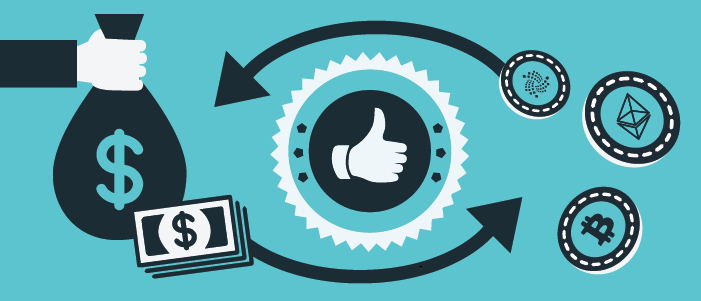Cryptocurrency Knowledgebase – Exchanges
What is a Bitcoin Exchange?
Chapter 6.1
A bitcoin exchange is a digital marketplace where traders can buy and sell bitcoins. In the early days of bitcoin, when bitcoin was the only cryptocurrency, exchanges were dedicated entirely to buying and selling bitcoin.
Today, most exchanges do not specialize exclusively in bitcoin. Today, most exchanges are cryptocurrency exchanges that offer a diverse range of trading pairs. You can find bitcoin, Ethereum, Bitcoin Cash, Litecoin, and dozens of other popular cryptocurrencies all listed on today’s major cryptocurrency exchanges.
Why Do We Need Bitcoin Exchanges?

Bitcoin is a decentralized cryptocurrency built using peer-to-peer transfer technology. Why do we need bitcoin exchanges? Isn’t the point of bitcoin to transfer money without the need for a centralized authority?
This is all true! Today, bitcoin continues to be easy to transfer from person to person (P2P). However, P2P transfers aren’t ideal for most trading activities.
With P2P transfers, there are certain drawbacks. If you want to buy 10 BTC from the market immediately, then you need to find a seller willing to sell you 10 BTC. This can be a time-consuming and expensive process. A bitcoin exchange organizes trades. It matches buyers with sellers over a trading engine. Buyers can purchase bitcoin simultaneously from a multitude of different sellers.
Bitcoin exchanges are also useful because they facilitate cross-chain transfers. Completing a P2P transfer between bitcoin and Litecoin is impossible. Sure, you can send bitcoin to someone’s bitcoin address and they can send Litecoin to your Litecoin address in return. However, this exchange doesn’t take place simultaneously. A bitcoin exchange facilitates cross-coin and cross-chain transfers, allowing you to trade bitcoin for altcoins and vice versa.
How Do Bitcoin Exchanges Work?

Bitcoin exchanges or cryptocurrency exchanges all work in a similar way. They function like a stock exchange by matching buyers with sellers.
The main purpose of an exchange is to match buy orders with sell orders. Buyers are trying to buy bitcoins while sellers are trying to sell bitcoins. A cryptocurrency exchange matches these two parties together to facilitate a trade.
Types of Cryptocurrency Exchanges

There are multiple types of cryptocurrency exchanges. In the early days of bitcoin and crypto, most exchanges were centralized custodial exchanges. Today, we’re seeing an increased number of non-custodial exchanges and decentralized exchanges. However, 99% of bitcoin trading activity continues to take place over centralized exchanges, with most centralized exchanges being custodial exchanges.
Confused? Here are the three main types of cryptocurrency exchanges, including custodial centralized exchanges, non-custodial centralized exchanges, and decentralized exchanges.
Custodial Centralized Exchanges

In a custodial bitcoin exchange, the exchange holds your cryptocurrencies within its own wallets. You don’t have full control over your cryptocurrency funds. They’re held in the wallet of the exchange. Today, approximately 75% of cryptocurrency exchanges are custodial exchanges: they hold the funds of users in wallets on-site. If a user wants to withdraw funds, he or she needs to submit a withdrawal request, at which point the coins will be removed from the exchange’s wallet and sent to the user’s wallet.
The vast majority of popular bitcoin exchanges – like Bittrex, Bitfinex, and Gemini – are custodial exchanges. You’re expected to deposit funds into the exchange and trust the exchange to keep your funds secure.
Custodial exchanges have pros and cons. The biggest concern is that you need to trust the exchange to manage your funds. Major cryptocurrency exchanges are constantly bombarded by hacking attacks. Periodically, a hacker breaks past the defenses and steals cryptocurrency. We saw this with the Mt. Gox hack in 2014: Mt. Gox once handled 75% of bitcoin exchange traffic before it got hacked. Then, it lost hundreds of millions of dollars’ worth of bitcoin overnight, leading to catastrophic consequences.
Custodial exchanges are considered to be “centralized” exchanges because your money is stored in a centralized wallet. Your orders are matched by a centralized matching engine. There’s a private, closed platform that acts as the middleman between the buyer and the seller. You pay a fee to this centralized authority and trust that they’ll complete trades fairly.
Non-Custodial Centralized Exchanges
Non-custodial exchanges are another type of centralized exchange. With a non-custodial exchange, you can interact with buyers and sellers over a centralized matching engine. Your funds, however, remain in your control during the trading process. You don’t need to relinquish custody of your funds. It’s a non-custodial trading platform.
In other words, a custodial exchange holds your money while a non-custodial exchange does not hold your money.
In a non-custodial exchange, your money is never held by the exchange. Instead, all trades are made instantly between buyers and sellers. The buyer receives your coins the same instant you receive the seller’s funds. You don’t need to deposit funds into a centralized account or wallet for trading.
The best-known non-custodial exchanges available today include Shapeshift, Changelly, and Evercoin. All of these exchanges allow you to swap tokens instantly – in exchange for a fee – without actually depositing your coins into a centralized platform.
Decentralized Exchanges

Decentralized exchanges, or DEXs, currently account for about 1% of cryptocurrency market trading activity. Some believe that DEXs are the way of the future, while others believe they’re too impractical to ever take off.
In any case, decentralized exchanges work much differently than the two centralized exchange types mentioned above. A decentralized exchange uses an open-source, permissionless, on-chain platform where trades can take place. That means there’s no need to trust a third party with your private keys. You don’t need to match with a buyer or seller across a centralized matching engine.
How can trades take place if there’s no centralized matching engine? Decentralized exchanges use smart contracts on the Ethereum network (or other blockchain networks) to facilitate trades between buyers and sellers. The biggest decentralized exchanges available today typically specialize in ERC20 token trading.
Instead of trusting a centralized third party, decentralized exchanges allow you to trust smart contracts on the Ethereum network. You need to put a lot of faith in the smart contract itself. However, you’re free to check this open-source smart contract at any time to verify everything is correct.
Today, decentralized exchanges are not a legitimate threat to the future of cryptocurrency exchanges. However, things could easily change within 2 to 5 years.
One thing that could make decentralized exchanges more prominent is cross-chain atomic swapping. This technology allows cryptocurrencies on different blockchains to be traded for one another instantly. Up above, we mentioned that buyers and sellers exchange coins instantly, with no lag or need to transfer coins between a centralized party. Cross-chain atomic swapping could allow that for more than just ERC20 tokens: it could allow it for all blockchain-based cryptocurrencies.
There’s one big problem with decentralized exchanges today: they account for just 1% of trading activity on the market. This means liquidity is an issue on many decentralized exchanges. It can be difficult to match buyers and sellers outside of the top cryptocurrencies.
The most popular decentralized exchanges available today include IDEX, Waves DEX, OpenLedger DEX (run by Bitshares), CryptoBridge DEX, and Bisq (run by BitSquare).
Types of Bitcoin Exchange Orders

Generally speaking, there are two types of orders on a bitcoin exchange, including market orders and limit orders.
Market Orders: With market orders, a trader can buy or sell bitcoins immediately based on the best currently available price. If you want to buy or sell crypto at the last price at which it was bought or sold, then a market order is what you want to do.
Limit Orders: A limit order allows you to set a specific limit at which you’ll buy or sell a particular asset. You might not feel comfortable buying bitcoin at $10,000, for example, so you set a limit order to buy 0.5 BTC at $7,000. If the price of bitcoin falls to $7,000, your order will be processed and you’ll purchase bitcoin from the market at $7,000 per BTC.
Makers and Takers

There are two participants on bitcoin exchanges, including makers and takers. When looking at a bitcoin exchange’s fee structure, you’ll typically see a maker fee and a taker fee.
Makers: A maker is someone who “makes” an order on a bitcoin exchange. You might “make” an order when you offer to pay $7,000 per BTC. You’ve now made an order and that order will set on the order book until someone “takes” it.
Takers: A taker is someone who “takes” an order from a bitcoin exchange. You might visit an exchange and see an offer from a buyer willing to pay $7,000 per BTC. You accept that offer and “take” the order.
Generally speaking, cryptocurrency exchanges want lots of orders posted on their exchange for maximum liquidity and the lowest possible spread. That’s why takers typically pay lower fees than makers. An exchange might set a maker fee of 0.1% and a taker fee of 0.2%.
How Do Bitcoin Exchanges Make Money?
Transaction Fees

Bitcoin exchanges make money by charging a transaction fee. The vast majority of exchanges charge a transaction fee. Unless an exchange is in a brief promotional period, you’re unlikely to find an exchange charging 0% transaction fees.
Typically, an exchange will charge transaction fees ranging from 0.1% (considered a cheap transaction fee) to 0.5% (considered an expensive transaction fee).
Exchanges generally offer volume-based discounts for higher-volume traders. If you trade, say, more than 50 BTC per month, then you might pay fees of just 0.01% on some exchanges, for example.
Additional Fees

Transaction fees are one of several was bitcoin exchanges make money. Bitcoin exchanges also make money through:
Deposit Fees: Some exchanges charge a fee to deposit money into the platform. Other exchanges charge no deposit fees whatsoever but charge higher fees upon withdrawal.
Withdrawal Fees: Virtually all exchanges charge withdrawal fees. Some exchanges have a certain minimum amount required before you can withdraw. You might pay 0.0001 BTC to withdraw your bitcoin from the exchange, for example. This fee can cover the exchange’s own transaction costs, including the fee paid to use the bitcoin network.
Currency Conversion Fees: Certain local exchanges will charge currency conversion fees. The exchange might offer to transfer your Canadian Dollars or Australian Dollars into bitcoin, for example. There are few exchanges that offer CAD/BTC or AUD/BTC pairs, so these exchanges are charging an exchange rate fee for the convenience.
Cryptocurrency exchanges are extremely profitable. In March 2018, Bloomberg analyzed the activity of the top 10 cryptocurrency exchanges in the industry. They calculated that the highest-volume exchanges – like Binance, Upbit, Huobi, and Bittrex – were generating $2 to $3 million per day in trading revenue. The majority of this revenue comes through trading fees, including maker and taker fees as mentioned above.
Conclusion
Ultimately, the world of bitcoin exchanges used to be the Wild West. There were no regulations, limited security measures, and varying fee structures. Today, the world of bitcoin exchanges is a highly competitive environment filled with major players and high-volume exchanges that offer competitive fee structures and enterprise-grade security while processing millions of dollars in transactions per day.
In the next chapter, we’ll list the most popular exchanges available today, including which cryptocurrency exchange or bitcoin exchange might be the right choice for you.
Best Cryptocurrency Exchanges List
Chapter 6.2
There are hundreds of cryptocurrency exchanges available online today, including top 10 exchanges with high liquidity and smaller exchanges with more unique coin selections.
Which exchange is right for you? Choosing the right exchange can be a confusing process. In this chapter, we’ll list the most popular cryptocurrency exchanges available today. We’ll also explain what you should look for in a good cryptocurrency exchange.
Top 5 Ways to Choose the Best Cryptocurrency Exchange

What should you consider when shopping between cryptocurrency exchanges? Here are some of the most important factors when comparing exchanges:
Fees:
Most of the biggest exchanges have competitive fee structures. Unless you’re dealing with a niche, specialized exchange – like a regional exchange or an exchange for a specific country – you’re unlikely going to encounter fees above 0.5% on standard trading. Nevertheless, it’s always a good idea to check an exchange’s maker fees and taker fees to make sure they’re competitive.
Volume Discounts:
Are you a high-volume trader? If you plan on trading, say, more than $50,000 per month across all cryptocurrencies, then you might qualify for high-volume trading discounts at certain exchanges. Exchanges like to attract the biggest cryptocurrency holders, and they do that by offering competitive fees. The higher your trading volume is, the lower your fees will be. Some exchanges drop fees to virtually 0% for the highest volume traders.
Payment and Withdrawal Options:
Some exchanges do not accept fiat currencies. They only accept cryptocurrency deposits and withdrawals. Other exchanges are totally compliant with banking systems and allow easy bank transfers or wire transfers. Exchanges have a number of different withdrawal and deposit options. Check payment and withdrawal methods to make sure they work for your needs.
Location:
The location of an exchange is important. You might want to work with a locally-based exchange to transfer your fiat currency into cryptocurrency for the first time. A major exchange like Bittrex might not accept regional payment methods like INTERAC for Canadian Dollars or BPAY for Australian Dollars. However, smaller Canada or Australia-based exchanges will accept both of these transfer methods. Location is also important in terms of regulation. Many exchanges are based in the United States and are fully-compliant with US banking laws. Other exchanges operate in a grey area by registering themselves in a little-known country and operating by the obscure regulations of that country.
Reputation, Customer Service, and Other Factors:
Exchanges vary widely in terms of customer service, reputation, and other factors. The good exchanges have risen to the top because they have a proven track record of providing a superior customer experience.
Top 10 Cryptocurrency Exchanges for 2018
Coinbase

Coinbase is headquartered in San Francisco. The exchange was founded in 2011 and is one of the most-popular and best-known exchanges on the internet today. Coinbase is more of a payment platform than an exchange: it facilitates easy payments using credit cards and other popular payment methods. Coinbase charges a high fee of as much as 5% for certain credit card payments, but it also offers unparalleled convenience and a US-compliant regulatory structure.
GDAX

GDAX is the cryptocurrency exchange division of Coinbase. They’re run by the same back-end. The main difference with GDAX is that it offers a more conventional exchange interface – complete with buy and sell orders and a transparent matching engine. If you’re looking for a beginner-friendly way to buy cryptocurrency for the first time, then Coinbase is a good option. If you’re okay with dealing with a more advanced interface similar to what you’d see on a conventional exchange, then GDAX is a popular cryptocurrency exchange offering competitive fees and a diverse range of coins.
Kraken

Kraken launched in 2011 in San Francisco. Today, Kraken typically sits among the top 10 or top 15 cryptocurrency exchanges by trading volume. Traders enjoy competitive fees while dealing with major cryptocurrency trading pairs, including BTC/EUR, ETH/EUR, BTC/USD, ETH/BTC, and XRP/EUR, among many others.
Binance

Binance is one of the newest cryptocurrency exchanges on the market. Launched in 2017, it quickly grew to become one of the highest-volume exchanges on the internet. Today, it routinely sits in the number one spot in terms of 24 hour trading volume. Binance is popular for its use of Binance Coin (BNB), which allows token holders to get steep discounts on trading fees. Binance also has a competitive fee structure and a diverse selection of cryptocurrencies from which to choose.
OKEx

OKEx is a popular digital currency exchange offering competitive fees and strong liquidity across a diverse selection of trading pairs. It’s a user-friendly exchange registered in the UK.
Huobi

Huobi is a Beijing-based cryptocurrency trading platform that is rapidly opening exchanges around the world. Today, Huobi is routinely ranked in the top 5 cryptocurrency exchanges by trading volume. Like Binance, Huobi has its own token (the Huobi Token or HT) that provides steep discounts on trading fees. As with all other exchanges on this list, Huobi offers competitive fees, strong liquidity, a compliant environment, and an easy trading interface.
Bitfinex

Bitfinex is one of the best-known exchanges available today. Bitfinex’s parent company, iFinex Inc., is headquartered in Hong Kong. Today, Bitfinex serves customers in 50+ countries worldwide. Bitfinex is one of the most controversial exchanges in our list of top exchanges. In 2015, the exchange was hacked. The exchange has also faced criticism for its connection with the controversial Tether cryptocurrency. According to reports online, the CEO of Tether and Bitfinex is the same person. Despite the controversy, Bitfinex remains one of the largest and most popular exchanges by trading volume.
Bittrex

Bittrex is a popular top 10 cryptocurrency exchange that, like others on this list, offers competitive fees, diverse deposit and withdrawal options, an easy interface, and a range of different cryptocurrency trading pairs. Bittrex is headquartered in Seattle with an office in Las Vegas.
Gemini

Gemini is a popular New York-based cryptocurrency exchange founded in 2015 by the Winklevoss twins – yes, the same Winklevoss twins that were linked with Facebook. Gemini remains one of the most popular and highest-volume exchanges online today. The exchange is also attempting to be one of the first major exchanges to target the institutional trading crowd in a major way.
LocalBitcoins

LocalBitcoins is worth a mention here. It’s not strictly a cryptocurrency exchange. Instead, it’s kind of like Craigslist for individual cryptocurrency exchanges. You can use LocalBitcoins to find a bitcoin buyer or seller in your local area. You can arrange in-person cash transfers with that individual. Or, you can deposit money into a bank account of that person’s choice and then receive an instant bitcoin transfer in return. The marketplace charges a small fee in exchange for holding funds in escrow and tracking the reputation of merchants across the platform. If you want to buy or sell cryptocurrencies without messing around on an exchange, then LocalBitcoins might be your preferred method.
Conclusion
There are – quite literally – hundreds of cryptocurrency exchanges available today. These exchanges vary widely in terms of popularity, regulations, coin variety, and other factors. If you’re working with the top 10 cryptocurrency exchanges, you’re going to find a similar experience across all of the options listed above. All of the above exchanges offer competitive fees, strong liquidity, easy deposits and withdrawals, and decent customer service.
In the next chapter, we’ll explain how you can start trading cryptocurrencies on a popular exchange. By following the lessons in the next chapter, you can buy your first bitcoin or crypto within a few hours!
How to Trade Using Bittrex
Chapter 6.3
Bittrex is one of the more popular exchanges available online today. The exchange consistently sits in the top 10 exchanges by trading volume. It offers strong liquidity across a diverse selection of trading pairs along with competitive fees and strong customer service.
Ready to get started with Bittrex? Keep reading to discover the step-by-step guide to buying or selling your first crypto or bitcoin with Bittrex.
1. Create an account. Visit Bittrex.com and click the “Sign Up” button.
2. Begin the registration process by entering your email address and desired password and agreeing to the terms of service.
3. Verify your email address by clicking the activation link sent to your inbox.
4. After clicking the activation link, you’ll be able to sign into your Bittrex address. You will need to verify your phone number. Enter your phone number and verify the text message sent to your number.
5. Next, activate two factor authentication (2FA) to protect your account. 2FA ensures you and only you can open your account. It means you’ll be prompted to enter a second authentication verification when you login to your account from an unfamiliar device or location. 2FA is optional, but recommended.
6. Create a wallet. Now that you have purchased bitcoins, registered your Bittrex account, and secured it with 2FA, you can create a wallet on Bittrex. This part is surprisingly easy. Just click on the Wallets tab on the top right corner of your screen. Then, look for the list of cryptocurrencies. Click the “plus” symbol beside a currency like bitcoin, and Bittrex will automatically generate a wallet. If you are purchasing coins for the first time from the Bittrex market, then the platform will automatically create a wallet for whichever coin you’re purchasing. You can use your Bittrex wallet to deposit or withdraw funds from your Bittrex account.
7. Deposit money into Bittrex. Bittrex works best for cryptocurrency deposits. To add bitcoins to your Bittrex wallet, open your existing bitcoin wallet app. Then, scan the QR code provided by your Bittrex wallet (generated when you pressed the “plus” symbol in the step above). Alternatively, copy and paste the string of characters into your wallet app. Verify the wallet address is correct before you confirm the deposit. After you deposit bitcoin, it might take anywhere from 10 minutes to 24 hours for the bitcoin to appear in your wallet balance. Before depositing money into Bittrex, you may need to complete KYC/AML verification, which involves taking a picture of your government-issued photo ID and submitting a selfie of you holding your ID. This verification can take anywhere from 5 minutes to a week, depending on how many new registrations Bittrex is currently processing.
8. Buying bitcoin for the first time? If so, then you’ll need to visit a website like Coinbase to purchase your first bitcoin using a credit card, bank transfer, or other payment method. Bittrex exclusively accepts cryptocurrency deposits in bitcoin or Ethereum. Once you have bitcoin or Ethereum, then you can transfer money into Bittrex and begin making trades. We explained how to setup your bitcoin wallet and purchase your first bitcoin in previous chapters.
9. So you’ve created an account on Bittrex and deposited funds into your account. Now, you’re ready to start trading. There are multiple markets available through Bittrex, including bitcoin markets and Ethereum markets. The bitcoin markets section will include pairs like BTC/LTC while the Ethereum markets section will include pairs like ETH/LTC. Bittrex also supports Tethers, which means you can trade cryptocurrencies for USD Tethers. USD Tethers, or USDT, are theoretically valued 1:1 with the USD. You can use USDT to hedge your bets while the crypto markets fluctuate.
10. Choose the bitcoin or Ethereum market on which you wish to trade. Once you’ve found your desired trading pair, you’ll see a trading dashboard. This dashboard will have a “Buy [Coin]” section on one side and a “Sell [Coin]” section on the other side. Under both headers, you’ll see a “units”, “ask”, and “type” option. “Units” lists the number of units (like the number of ETH) you wish to purchase. The bid refers to the price you’re willing to pay per unit. And the type refers to the type of order you wish to place (market or limit). If you just want to buy cryptocurrency at the market rate, then click “Market” under type and enter the number of units you wish to purchase. Once you’ve verified the information, click “Buy [Coin]” or “Sell [Coin]” to send your order to the Bittrex matching engine.
11. Bittrex will accept and process your trade. If you’re purchasing a small amount of crypto at the market rate in a high-volume market, then your order should be processed instantly. You should see a pop-up appear in the top-right corner of your screen while your order is being processed. The pop-up will track the progress of your trade, and you might see a green progress bar underneath the box. You can also view pending or completed orders on your account dashboard. Once you’ve completed this step, that’s it! You’ve successfully made a trade using Bittrex. Whether you’re purchasing bitcoin for the first time or selling cryptocurrency for another cryptocurrency, you can use Bittrex for all types of bitcoin trading, Ethereum trading, and altcoin trading.











